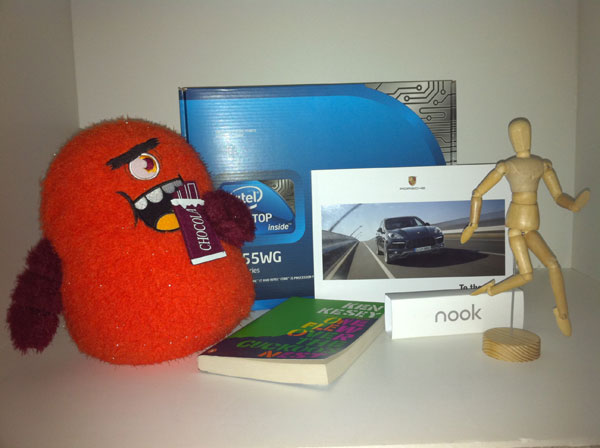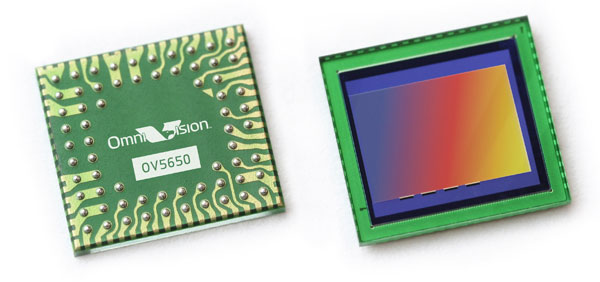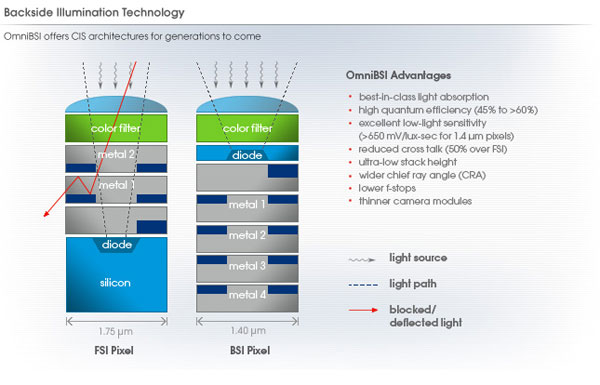Apple's iPhone 4: Thoroughly Reviewed
by Brian Klug & Anand Lal Shimpi on June 30, 2010 4:06 AM EST- Posted in
- Smartphones
- Apple
- iPhone 4
- Gadgets
- Mobile
Welcome to 2010, Apple Upgrades its Camera
The iPhone 4 is equipped with two cameras: a 5 megapixel camera with LED flash on the back of the phone and a VGA camera with no flash on the front. The LED flash works in both still and video modes. Like the EVO 4G, the iPhone 4‘s flash allows you to shoot in perfect darkness. If you’re filming a video in low light the LED will stay illuminated while you’re recording.

Taken with the iPhone 4 in total darkness
The same unfortunately can’t be said for the front facing camera on the 4. In anything but good lighting you’re going to get noise. It’s really only useful for FaceTime (or as an alternative to a mirror) and even then you need to be well lit for it to look decent.
Apple has opted for a 5 megapixel OmniVision sensor for the rear camera on the iPhone 4. What's interesting is that Apple has decided to bring backside illumination front and center with their marketing.
Backside illumination improves the sensitivity of CMOS and CCD detectors by reducing the amount of material in the path of incident light. In a frontside illuminated detector, a considerable amount of light is lost due to absorption that doesn't result in emission of an electron, in addition to reflection off pixel structures and electrical components near the frontside surface. Backside illumination greatly improves sensitivity by flipping the stack over. Instead of light having to pass through and possibly be reflected by metal structures, it is converted into electrons and read out by passing solely through silicon. Creating a backside illuminated part isn't as simple as flipping a sensor over, however, as manufacturers also generally thin the silicon light has to pass through before it can reach the photodiode. This further improves sensitivity and is generally accomplished through chemical etching in acid or by lapping (physically grinding) sensors at wafer scale.

OmniVision OV5650 - iPhone 4's rear camera SoC
Though backside illumination (BSI) improves quantum efficiency (how many photons are converted into electons), backside illumination is hugely important for another serious reason as well. Because the sensor is small at 4.6 mm by 3.4 mm, pixel size is also extremely small at just 1.75 microns square for the OV5650 in the iPhone 4 (state of the art sensors are 1.4 microns square, like those in the HTC Incredible's 8 MP sensor). Frontside illuminated parts generally have in the neighborhood of 10-15 microns of silicon before the active region of the photodiode where one wants photons to get converted to electrons. The result is that without backside illumination, pixels have a 10:1 ratio of height to length, you can visualize them as looking something like long square pillars. But that's a problem.
As photons are converted into electrons in that silicon, there's no guarantee that it will immediately travel down into the gate structure below to be read out by the camera. Electrons drift as they descend these columns, meaning that photons incident on one pixel don't necessarily map to the gate below. Because the smartphone camera sensors are so small, with a 10:1 ratio of height to size, the result is large amounts of so-called quantum blurring from electrons traveling into the gate structures of adjacent pixels. The result is a blurry image (and a decrease in MTF at the sensor level!), thus not representing the image that used to be incident on the sensor.
OmniVision and other smartphone CMOS sensor manufacturers thin that column down in an effort to come closer to having the pixel look more like a cube than a huge pillar. Ballpark numbers are between 3 and 6 microns, down from 10-15. The result is much more sensitive sensors that are higher resolution. While megapixels don't necessarily matter, neither does pixel size as much anymore; it's all about quantum efficiency, which is what engineers really care about.

OmniVision BSI - Courtesy OmniVision
The optical system of the iPhone 4 is difficult to characterize without disassembly, though the focal length is a bit shorter than previous iPhones. The result is that the photos are demonstrably wider angle. Backside illumination also allows for a bigger chief ray angle, higher numerical aperture (and thus lower f/#), but I won't bore you with the details.










270 Comments
View All Comments
Stuka87 - Wednesday, June 30, 2010 - link
Yet another top notch, in depth review Anand. I love the amount of depth you add to any review.One question, on the first page you refer to the SoC used in many Android devices as "Scorpion" rather than "Snapdragon." Is there an actual difference, or just different names for the same device? Or perhap Scorpion is more specific to the revision?
I am still thinking that for now I will keep my 3GS. next year when its time to upgrade, a new better iPhone will be out anyway.
Spoelie - Wednesday, June 30, 2010 - link
Scorpion is the CPU, Snapdragon is the entire SoC (with gpu etc etc)brandonicus - Wednesday, June 30, 2010 - link
Still reading the review, but from the first page pictures I have to ask...Did you already scratch your iPhone to hell? When seeing the front side comparison with the Nexus One I thought the iPhone looked terrible. Bad pictures? Or does it just scratch really easy?...I'm sure later in the review I'll read that you threw it on the ground a few dozen times :)ipredroid - Wednesday, June 30, 2010 - link
Many of your in-depth reviews have helped me decide on how to customize/purchase/learn about a product. Nevermind people saying you (Shimpi) are bias towards a product. People are just annoyed at anything Apple related because the media won't shut up about Apple. I realize you are smart enough not to respond to random haters and treat those here with respect and even respond to comments or questions. Thank you to the AnandTech team!The0ne - Wednesday, June 30, 2010 - link
Don't be a fool, many of us here are here at Anandtech because first many of us do like Anadtech ever since he started his site, secondly the reviews are good in general and lastly because most of us are either engineers or in the computer related field.What most of us criticized are valid to some extent. What I've criticized is immensely valid. Do the test and write the review without any type of unjustified opinions included. And if it's not too much trouble be CONSISTENT. I don't go around testing similar products every which way. I'm not saying Anandtech does this all the time but I get really annoy when things are not consistent from one review to the next; meaning testing was not consistent and thus results could be dark matter for all I know.
ipredroid - Wednesday, June 30, 2010 - link
You Proved my point, you randomly hated on a general comment I made, (which I made to no one in particular). No one here is a fool. Base your opinions off of facts not general assersens of which you are speculating. Misplaced criticism based on speculation is for tabloids. Which is unfortunately how you come across when you call people fools and bash with out facts. I'm sure you realize how Hypocritical you are being. You are entitled to your opinion of course but your ignorance shows when you don't base off of facts. (Referring to antenna issue) Apple and Google are both guilty of faulty antennas saying either company's engineers didn't test properly is just silly.The0ne - Thursday, July 1, 2010 - link
Your comprehension is misplaced. When I called you a "fool" it was in referenced to you saying."Nevermind people saying you (Shimpi) are bias towards a product. People are just annoyed at anything Apple related because the media won't shut up about Apple. I realize you are smart enough not to respond to random haters and treat those here with respect and even respond to comments or questions. Thank you to the AnandTech team!"
In short you are saying that some of us that have differing opinions on the subject matter are idiots and that Anand is smart to avoid us and our lame comments. That is pretty much your entire take on it. All I'm saying is that there are many professionals as members here on Anandtech, many of which are very intelligent. Assuming we're that dumb is foolish, and hence the use of the word "fool."
I'm sorry, this Antenna issue is a laughing stock to any respectable engineer. If could have only gone into the finish product by decisions made against the respectable Engineer(s). Whether you choose to believe otherwise is irrelevant because the FACT remains the problem is a basic one. Whether it's Apple, Google or our company is irrelevant as well. The discussion here is Apple iphone, thus the blame is directed at Apple. That does not imply it is ONLY Apple that does this.
And lastly where do you get off telling me I'm ignorant because of my "hate." Where is this hate you are talking about? You're making things up to justify your own means to have something to say to me, less the lack of comprehension in the first place. As for what I've said, that is very general. Why is asking "Do the test and write the review without any type of unjustified opinions included" full of hate?
Sorry you got the wrong idea of my original response.
ipredroid - Thursday, July 1, 2010 - link
I never said you were ignorant because of your hate... read it again... lol. Ignorant for calling me a fool and baseless facts (thank you for the apology). I even stated you ( everyone is) entitled to their opinion. Just stating some people comes across as "haters". People complain about everything, it is easier to see the bad rather than the good, human nature maybe.Anyways, I could careless, meant it as a thank you of sorts to the AnandTech team. Not to belittle other bloggers posts. To the overly negative with out sensible reasoning, yes. You, no. I enjoy reading others posts and rarely comment. I did this time because work put into the review by the AnandTech team seemed to be under appreciated in this review and I commented.
Of course anyone that runs a business isn't going to respond to distasteful posts rudely that wouldn't be smart. Not that those who are "haters" are idiots, even though they certainly can be.
IKeelU - Wednesday, June 30, 2010 - link
I liked the review. It seemed objective to me and I appreciate that the phone and OS were covered separately.Something that wasn't addressed: will the straight edges of the iPhone4 cause damage to one's pants (or one's purse)? My old Sony Ericsson candybar phone actually caused damage to the lining of my left pocket after several months of use. It seems like the iPhone4's edges are the sharpest-ever in a phone...
Though I must disagree about the iPhone 4 making the N1 look dated. In those photos, at least, the N1 looks way sexier to me.*
* I own an N1 ;)
tdream - Wednesday, June 30, 2010 - link
First of all calling the iphone 4 styling uptodate just because its new doesn't make any sense. Jobs says its like an OLD Lecia camera... The 3GS doesn't look dated in the objective sense. If you were to place these two devices in a test, a control group and another which was bombarded with marketing spiel (like the world has) you would get a vastly different viewpoint. Sharp edges are out, just because Apple have run out of ideas decided to be different doesn't mean it's better. Eg glossy vs matte, Apple have made matte cool again... even though all of my monitors are matte. Apple will do anything to be different and stand out, doesn't make it better though.Once again you ignore your own data and say the IPhone 4 is better than the 3GS even though in every case you tested it CLEARLY isn't. It a problem, you know it, Apple knows it, and now everyone in the world knows it. You "feel its better", well then if you feel it then I must feel it too right. Glad we live in a world which values science and facts too. Sorry but you're falling into Apple's main ploy right here, it's magical...
However the rest of your article remains fairly objective and up to your old high standards.